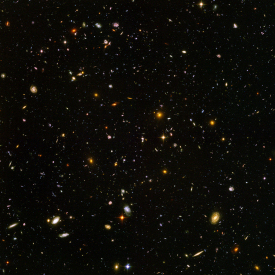Hubble - greatest discoveries
The Hubble Deep Fields:
How Hubble has observed the furthest away galaxies and the most ancient starlight ever seen by humankind
 |
|
The Hubble Ultra Deep Field. Credit: NASA, ESA, and S. Beckwith (STScI) and the HUDF Team |
One of the main scientific justifications for building Hubble was to measure the size and age of the Universe and test theories about its origin. Images of faint galaxies give "fossil" clues as to how the Universe looked in the remote past and how it may have evolved with time. The Deep Fields gave astronomers the first really clear look back to the time when galaxies were forming. The first deep fields – Hubble Deep Field North and South – gave astronomers a peephole to the ancient Universe for the first time, and caused a real revolution in modern astronomy.
Subsequent deep imagery from Hubble, including the Hubble Ultra Deep Field, has revealed the most distant galaxies ever observed. Because of the time it has taken their light to reach us, we see some of these galaxies as they were just half a billion years after the Big Bang.
Deep field observations are long-lasting observations of a particular region of the sky intended to reveal faint objects by collecting the light from them for an appropriately long time. The 'deeper' the observation is (i.e. longer exposure time), the fainter are the objects that become visible on the images. Astronomical objects can either look faint because their natural brightness is low, or because of their distance. In the case of the Hubble Deep and Ultra Deep Fields, it is the extreme distances involved which make them faint, and hence make observations challenging.
Using the different Hubble Deep fields astronomers were able to study young galaxies in the early Universe and the most distant primeval galaxies. The different deep fields are also a good gathering grounds to find the most distant objects ever observed (see also heic1103, heic1217, and heic1219).
Within 2012 and 2014 Hubble created two new deep fields: The Hubble eXtreme Deep Field is so far the deepest image ever taken of the sky so far and combines the light of one million seconds of observation. The last Hubble Ultra Deep Field released in 2014 was observed in ultraviolet. This image allowed astronomers to study star formation in a region 5 to 10 light-years away from us.
This is one of nine articles highlighting some of the greatest discoveries made by the Hubble Space Telescope. Read more in the articles linked from the right-hand menu.
